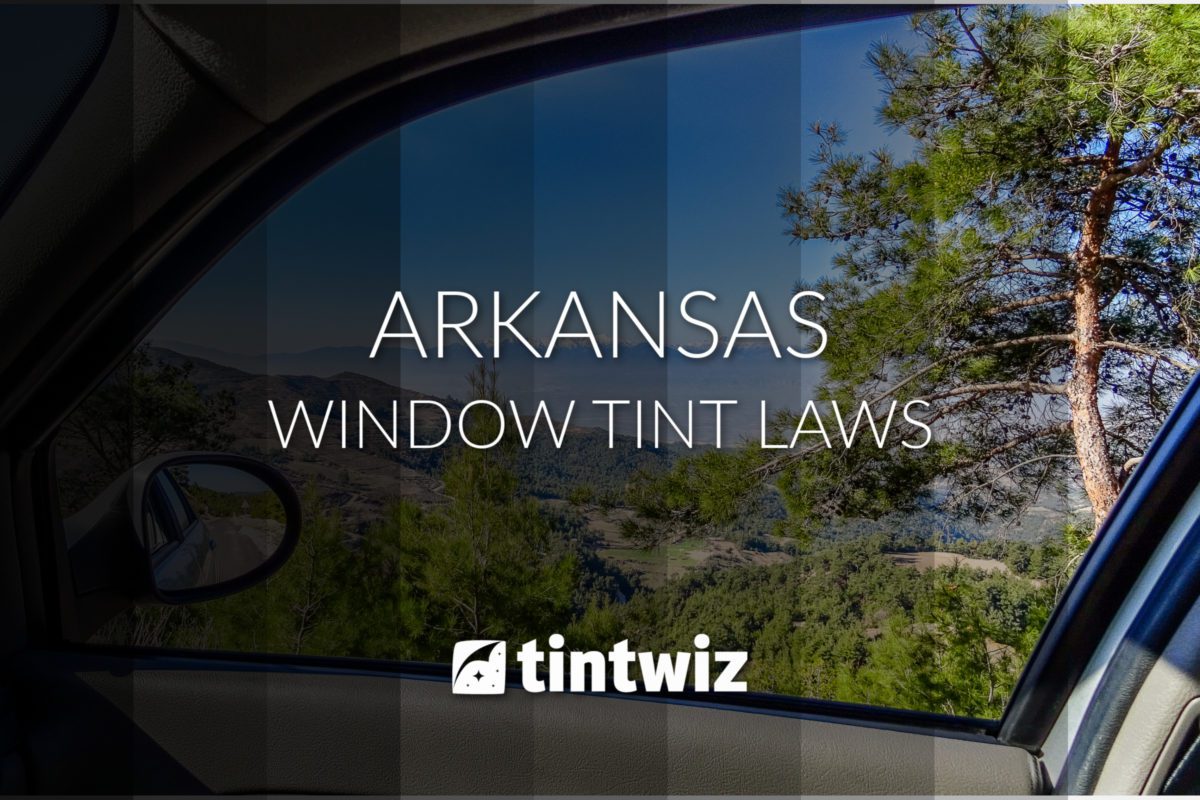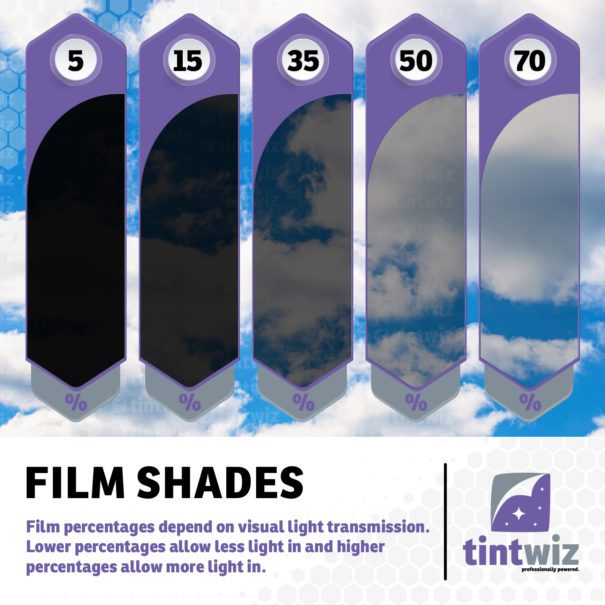Darkest legal tint for Sedans in Arkansas
- Windshield: Non-reflective tint is allowed on the top 5 inches of the windshield
- Front Side windows: Must allow more than 25% of light in
- Back Side windows: Must allow more than 25% of light in
- Rear window: Must allow more than 10% of light in
Darkest legal tint for SUV and Vans in Arkansas
- Windshield: Non-reflective tint is allowed on the top 5 inches of the windshield
- Front Side windows: Must allow more than 25% of light in
- Back Side windows: Must allow more than 10% of light in
- Rear window: Must allow more than 10% of light in
Table of contents
- Darkest legal tint for Sedans in Arkansas
- Darkest legal tint for SUV and Vans in Arkansas
- Can Car Front Side Windows and Windshields Be Tinted in Arkansas?
- Window Tint Laws for Trucks, SUVs, and Vans in Arkansas
- Are There Window Tint Color and Reflectivity Laws in Arkansas?
- Medical Exemptions for Car Window Tint Rules in Arkansas
- Legal Window Tint Certificates in Arkansas
- Illegal Window Tint Penalties in Arkansas
- Alabama Car Window Tint Laws
Please note: The accuracy, completeness, adequacy or currency of the content is not warranted or guaranteed. We are not lawyers or a law firm and we do not provide legal advice. We recommend you consult a lawyer or other appropriate professional if you want legal advice.

Looking to get your vehicle tinted but you are not sure what the Arkansas window. tint laws are? You’ve come to the right place. Below you’ll find the window tinting laws for the state of Arkansas as well as frequently asked questions about Arkansas tint laws.
The state of Arkansas has relatively permissive laws when it comes to window tint for a privately owned vehicle. But as new types of window tinting show up on the market and as Arkansas window tint laws change from year to year, it’s important to stay up to date on your knowledge of window film regulations if you have any tinting on your car, truck, van, or sport utility vehicle.
Though many types of automotive window tint are allowed in Arkansas, a window tint violation can be regarded as a Class B misdemeanor, which can come with heavy fines and even jail time, so while these penalties are unlikely to be stridently enforced, they should be more than enough to convince you to follow Arkansas window tint laws.
Can Car Front Side Windows and Windshields Be Tinted in Arkansas?
As vehicle window tint rules in Arkansas are different for cars and for vans, trucks, and SUVs, we’ll look at cars, meaning sedans, coupes, hatchbacks, and the like, in their own separate section: this information pertains specifically to car tint in Arkansas.
In Arkansas car window tint on the side windows may have a window tint that has a Visible Light Transmission (VLT) percentage rating of 25% or higher, meaning at least 25% of the sun’s visible light must be able to come through the tinted window into the cabin. The rear windshield of a car may be tinted down to 10% VLT, which looks almost opaque from a distance. (Note that even 25% VLT tinting is dark and is more than enough tint to offer privacy to occupants.)
A car’s windshield may have a non-reflective tint across the top five inches of the glass, and this tint is a must have for safe driving, as the sun’s glare can be blinding if not reduced.
Window Tint Laws for Trucks, SUVs, and Vans in Arkansas
Larger private vehicles like vans, trucks, and SUVs can have darker windows than cars under Arkansas state laws. While front side windows of these larger vehicles are limited to the same 25% VLT tint darkness, rear side windows can have windows tinted down to 10% VLT. (For reference, a 5% VLT rating is also called limo tint, and rejects the view into the vehicle entirely during daylight hours. 10% VLT is almost as dark.)
The rear windshield may also be tinted down to 10% VLT on trucks, vans, and sport utility vehicles. Rules regarding the front windshield are the same as with cars, meaning a five-inch band of non-reflective tint is allowed across the top of the glass.
Are There Window Tint Color and Reflectivity Laws in Arkansas?
Arkansas vehicle window tint laws outlaw reflective or metallic window tint on all surfaces of the car’s windows, from front windshield to side windows to rear window. While you cannot have a mirrored look to your car tint, you are allowed to us window tint of any color or shade in Arkansas, as the state’s laws do not expressly prohibit any color of window film.
That said, some colors of window tint can make the view out of a car less clear and are not advisable; a gray, green, blue, or smoke hued window tint are usually the best option for adding privacy and style to the vehicle but without reducing the clarity of the view through the window glass.
Bear in mind that as is the case in many states, obstructed windows can be a violation of Arkansas law, and if older, inferior window films become bubbled, cracked, peeled, or otherwise compromised in a way that it blocks the view through a window, the car’s tint may be considered illegal. Avoid using cheaper window tints that will discolor, bubble, and crack over time; the money you save up front is not worth the hassle of replacing the tint later or even risking an infraction based on the compromised window film. High quality ceramic based window film for cars in Arkansas can last for many years, and in many cases will last as long as the vehicle itself, thus is always money well spent.
As with some states, Arkansas regulations place no requirements dealing with side view mirrors in relation to window tint.
Medical Exemptions for Car Window Tint Rules in Arkansas
Under Arkansas state law, certain medical conditions allow a vehicle owner to use window tint on a vehicle that would not be legal without their specific medical exemption. For people with some skin or eye issues that necessitate extra protection against sunlight, a medical window tint exemption allows for darker window film on front side windows and for rear side windows in cars.
You should consult with a doctor and get an official, signed document showing you qualify for a medical window tint exemption and bring this document to a trusted window film installer before to having the otherwise illegal window film installed. And if you do get window tint applied thanks to such special circumstances, it’s important that you keep your doctor-approved paperwork in your car at all times so you can show the tint exemption to a police officer in order to prove the tint is permitted.
Do keep in mind that many optically transparent or almost transparent window tints still block up to 99% of the sun’s ultraviolet light, so you might not need dark windows if UV light exposure is what you need to limit. Clear window tint that blocks ultraviolet light is the best way to ensure compliance with Arkansas window film laws while still protecting your skin and eyes from UV light.
Legal Window Tint Certificates in Arkansas
In Arkansas, every window tint of a vehicle that has aftermarket window tint applied must have a sticker applied that clearly shows the window tint is in compliance with Arkansas state regulations. These sticklers must be placed between the glass and the window tint film and be visible from the outside. Proper application of these stickers can reduce the chance of an issue during a traffic stop and during an inspection of the vehicle as well.
Make sure you consult with your window tint provider before to the installation of window tint and ensure that they are using a window film allowed by Arkansas state rules and that they will apply these stickers as needed.
Illegal Window Tint Penalties in Arkansas
As noted, in the state of Arkansas, illegal window tint constitutes a Class B misdemeanor offence. The penalty for a window tint law violation in Arkansas can be steep: you can be assessed a fine of up tom $1000 and up to three months (90 days) in jail. While it’s unlikely that authorities would enforce the maximum penalty for window tint violations, especially on a first offence, those penalties can be quite harsh and should be avoided.
The tricky thing about window tint is that it’s impossible to conceal; anyone who can see your car can see your tint. So if you have windows that are near the darkest tinting possible under law but that are still legal, you may be drawing unwanted attention to yourself. Unless you demand the darkest legal tint in Arkansas based on style preferences, for privacy, or for any other reason, a safe bet is to get window tint what is noticeably more transparent than the darkest legal VLT, thus to avoid prompting an officer or inspector questioning your tint.
Remember, even transparent window tints block 99% of harmful UV light and can reduce warming infrared light and cut the harsh glare of the sun, while window tint with modest VLT reduction can still increase privacy. There is no need for extra dark windows if you are looking to enjoy the many benefits of window tint for automobiles.
The percent of visible light allowed through your car windows is called VLT: Visible Light Transmission. The percentage of light allowed through your film and glass in Arkansas is very specific and different for passenger car such as a sedan vs a multi-purpose passenger and recreational vehicle. The lower the % of the tint, the darker your window will be as the VLT is referring to the amount of light being let in.
Alabama Car Window Tint Laws
(a) It shall be unlawful to operate a vehicle on the public highways if after-market tinting material, together with striping material, has been applied to any windows of the vehicle or if letters or logos larger than one-quarter inch ( 1/4 ″) have been applied to the windows of the vehicle.
(b) After-market tinting of vehicle windows shall be lawful only as follows:
(1) The glass immediately in front of the operator may have a strip of tinting material applied to the top edge, known in the industry as an “eyebrow”, but it may not extend downward more than five inches (5″) from the top center of the windshield;
(2) On all 1994 model vehicles and later model vehicles, the side windows and side wings located on the immediate right or left of the driver or to the right or left immediately behind the driver may be covered with an after-market tinting material which results in at least twenty-five percent (25%) net light transmission, except that the side windows immediately behind the driver on any truck, bus, trailer, motor home, or multiple purpose passenger vehicle may be covered with an after-market tinting material which results in at least ten percent (10%) net light transmission; and
(3) On all 1994 model vehicles and later model vehicles, the rearmost window may be covered with an after-market tinting material which results in at least ten percent (10%) net light transmission.
(c) Any vehicle that is operated on Arkansas roads with after-market tinting material on any glass shall have attached to the front glass immediately to the operator’s left a label containing the name and phone number of the company installing the tinting material and affirming that all tinting on the vehicle conforms to the requirements of this section.
(d) The provisions of this section shall not apply to motorists operating vehicles registered in other states that have enacted legislation regulating the shading of windshields or windows of motor vehicles who are driving on Arkansas roads and highways.
(e)(1)(A) A motorist is exempt from this section if the motorist is diagnosed by a physician as having a disease or disorder, including, but not limited to, albinism or lupus, for which the physician determines it is in the best interest of the motorist to be exempt from the requirements of this section. The motorist shall carry in his or her motor vehicle a physician’s certification.
(B) The installation of tinted glass is exempt from this section if the tinted glass is installed in the motor vehicle of a person exempted under this subsection, as evidenced by a physician’s certification.
(C) For vehicles tinted prior to August 16, 2013, this subdivision (e)(1) applies. Proof of the date of the application of the tint and the name and phone number of the company that applied the tinting shall be carried in the motor vehicle.
(2) After August 16, 2013, a motorist that provides a physician’s certification attesting that it is in the best interest of the motorist to have such tinting may have window tinting performed as follows:
(A) The side windows and side wings located on the immediate right or left of the driver or to the right or left immediately behind the driver may be covered with an after-market tinting material which results in at least twenty percent (20%) net light transmission;
(B) The rearmost window may be covered with an after-market tinting material which results in at least ten percent (10%) net light transmission; and
(C) The front windshield may be covered with an after-market tinting material which results in at least fifty percent (50%) net light transmission.
(3) After August 13, 2013, a vehicle operated on Arkansas roads with after-market tinting material on the glass under this section shall have attached to the front glass immediately to the operator’s left a label from the window tinting installer that:
(A) Provides the name and phone number of the company that installed the tinting material; and
(B) Affirms that all tinting on the vehicle conforms to the requirements of this section.
(4) A motorist utilizing the provisions of this section shall carry the physician’s certification in the motor vehicle.
(5) Any physician certification issued in compliance with this subsection shall be valid for three (3) years from the date of issue.
(6) Upon transfer of a vehicle with window tinting under the medical waiver exemption, the transferor shall:
(A) Disclose that the window tinting is not within legal limits without a medical waiver; or
(B) Remove the tinting that was based on the medical waiver.
(f) The provisions of this section shall not be applicable to vehicles or operators of vehicles used exclusively or primarily for the transportation of dead human bodies.
(g) Any installer of motor vehicle glass tinting material who installs any glass tinting in violation of this section or otherwise violates the provisions of this section or any person operating any motor vehicle with glass tinting or other after-market alteration of the glass in the vehicle which is contrary to the provisions of this section shall be guilty of a Class B misdemeanor.
(h) The provisions of this section shall also apply to:
(1) All 1993 and older model vehicles which have not had after-market tinting material applied in accordance with Acts 1991, No. 563 [repealed], or Acts 1991, No. 1043 [repealed]; and
(2) At such time as the ownership of the same are transferred, all older model vehicles which have had after-market tinting material applied in accordance with Acts 1991, No. 563 [repealed], or Acts 1991, No. 1043 [repealed].
(i) Notwithstanding any other provision of this section or any other law to the contrary, windshields of law enforcement vehicles may be tinted to the extent that the windshield permits at least fifty percent (50%) net light transmission.
(j) This section does not apply to a sedan under § 27-37-307
§ 27-37-307. Window tinting on chauffeur-driven sedans
2018 Arkansas Code
Title 27 – Transportation
Subtitle 3 – Motor Vehicles and Their Equipment
Chapter 37 – Equipment Regulations
Subchapter 3 – Glass and Mirrors
§ 27-37-307. Window tinting on chauffeur-driven sedans
Universal Citation: AR Code § 27-37-307 (2018)
(a) (1) As used in this section, “sedan” means a motor vehicle that:
(A) Has been licensed as an automobile for hire under § 27-14-601(a)(2);
(B) Accommodates a minimum of three (3) rear passengers; and
(C) Is chauffeur-driven.
(2) A sedan is not a taxicab or van.
(b) A sedan that is licensed as an automobile for hire may have the following window tinting:
(1) On the rear passenger doors of the motor vehicle, tinting that results in at least fifteen percent (15%) net light transmission, and on the rear windshield of the motor vehicle, tinting that results in at least ten percent (10%) net light transmission;
(2) A strip of window tinting material applied to the top edge of the front windshield, known in the industry as an “eyebrow”, if the tinting results in at least ten percent (10%) net light transmission; and
(3) Window tinting on the front passenger doors that results in at least twenty-five percent (25%) net light transmission.
(c) A sedan in compliance with this section is exempt from § 27-37-306.
(d) (1) Except as provided under subdivision (d)(2) of this section, a person or entity that owns a sedan with window tinting under this section shall remove the tinting allowed under this section and return it to compliance with § 27-37-306 when the sedan is:
(A) Sold to another person or entity that is not in the business of renting automobiles for hire; and
(B) No longer expected to be used as a sedan for hire.
(2) If the window tinting is not a film but an actual tinting of the glass, subsection (d)(1) of this section does not apply.









